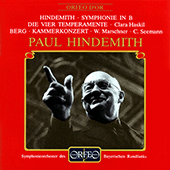Paul Hindemith
Born into a poor family, Hindemith began his musical studies with the encouragement of his father at the age of twelve. Between 1908 and 1917 he studied violin and composition at the Hoch Conservatory in Frankfurt and in 1915 he joined the orchestra of the Frankfurt Opera as leader, staying there until 1923. Following the death of his father in 1915 he earned extra money by teaching and playing in cinemas and inns, an experience which engendered the utilitarian approach to music which he retained all his life. Hindemith also played the viola in the string quartet of his teacher Adolf Rebner, and from 1921 to 1929 in the Amar-Hindemith Quartet. While with the Frankfurt Opera he attracted the attention of the conductor Fritz Busch, who was looking for new composers and conducted two short expressionist operas by Hindemith at Stuttgart in 1921.
Throughout the 1920s Hindemith composed prolifically, adopting various styles ranging from the neo-Baroque to jazz; he was also involved in the running of the Donaueschingen Festival from 1923 to 1930, and from 1927 taught composition at the Berlin High School for Music. In 1929 Hindemith visited London to give the first performance of Walton’s Viola Concerto at the invitation of the composer, returning the following year to give the premiere of his own concerto for the same instrument. Between 1935 and 1937 he visited Turkey regularly to assist with the establishment of a music school there, and in January 1936 he gave the first performance in London of his Trauermusik (Mourning Music), conducted by Sir Adrian Boult, having composed the work during the previous night after the scheduled concert programme had to be changed due to the death of King George V.
Hindemith’s strong sense of ethics and his belief that music could possess a social purpose brought him into conflict with the National Socialist Party following its assumption of power in 1933. His opera Mathis der Maler dramatised the dilemmas of the artist in society at a time of conflict, and the 1934 performance by Furtwangler of the symphony drawn from the operatic score aroused the opposition of the government: both opera and symphony were banned. Having made his first visit to America in 1937, at the end of that year Hindemith resigned from his teaching post in Berlin. He sought exile in 1938 in Switzerland, leaving there in 1940 to settle in America and becoming an American citizen in 1946; he accepted teaching posts at Yale University and at Tanglewood, where his pupils included Leonard Bernstein. In 1947 Hindemith returned to Europe and began to conduct his own works in concert, but continued with his academic work, accepting university appointments at Harvard (1949–1950) and at Zurich (from 1951). He received numerous honorary awards, including a doctorate from Oxford University; and having resigned from Yale in 1953, returned to Europe permanently.
Henceforth Hindemith was active both as a conductor and as a composer, with the latter role often having to give way to the demands of the former: indeed immediately before his death in 1963 he had conducted the first performance of his Messe in Vienna. Hindemith’s studio recordings consist exclusively of his own compositions, although live concert recordings have been issued with him directing a slightly wider repertoire. Notable among his commercial discs are those made for the English Columbia label with the Philharmonia Orchestra. The repertoire for this series included his Konzertmusik No. 3 (for strings and brass), Nobilissima Visione, Symphonia Serena, the Horn Concerto with Dennis Brain and the Clarinet Concerto with Louis Cahuzac. As the pre-eminent German composer of his generation, Hindemith was also recorded by Deutsche Grammophon, and with the Berlin Philharmonic Orchestra he conducted his Mathis der Maler Symphony, Symphonische Tanze, the Concerto for Orchestra and one of his most popular works, the Symphonic Metamorphosis on Themes of Carl Maria von Weber. Decca recorded him conducting his Violin Concerto with David Oistrakh as soloist, and the American label Everest released Viennese concert recordings of him conducting his Die Harmonie der Welt Symphony and Requiem for Those We Love, which used as its text Walt Whitman’s poem When Lilacs Last in the Dooryard Bloom’d. On all these recordings Hindemith shows himself to have been an efficient and disciplined conductor, if one whose emotional range was at times limited.
© Naxos Rights International Ltd. — David Patmore (A–Z of Conductors, Naxos 8.558087–90).


















